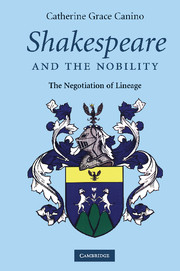Book contents
- Frontmatter
- Contents
- List of illustrations
- List of appendices
- Acknowledgments
- Introduction: the nobility and genealogy
- 1 The Staffords (Dukes of Buckingham)
- 2 The Dukes of Suffolk
- 3 The Nevilles (Earls of Warwick)
- 4 The Talbots (Earls of Shrewsbury)
- 5 The Cliffords (Earls of Cumberland)
- 6 The Stanleys (Earls of Derby)
- 7 The gentry (William Lucy, Lord Saye)
- Conclusion
- Appendices: genealogical charts
- Index
6 - The Stanleys (Earls of Derby)
Published online by Cambridge University Press: 03 July 2009
- Frontmatter
- Contents
- List of illustrations
- List of appendices
- Acknowledgments
- Introduction: the nobility and genealogy
- 1 The Staffords (Dukes of Buckingham)
- 2 The Dukes of Suffolk
- 3 The Nevilles (Earls of Warwick)
- 4 The Talbots (Earls of Shrewsbury)
- 5 The Cliffords (Earls of Cumberland)
- 6 The Stanleys (Earls of Derby)
- 7 The gentry (William Lucy, Lord Saye)
- Conclusion
- Appendices: genealogical charts
- Index
Summary
Thomas, Lord Stanley is a relatively minor character in the First Tetralogy. He is yoked wordlessly together with William Hastings in the Henry VI plays, but he ultimately finds his consequence and voice in Richard III. Despite his relegation to a dramatically minor role, the historical Stanley was a critical figure in the establishment of the Tudor regime. His descendants, who held the Earldom of Derby, were among the most powerful, celebrated, and durable families of the sixteenth century. In essence, they ruled the northwest of England and were in such secure positions that not even tremendous debt, damaging gossip, and a proximity to treason could undo them. Throughout the Elizabethan reign, the earldom was held by Henry Stanley. The fourth Earl of Derby was a man dogged by scandal. He suffered marital and financial woes, and because of his family's Catholic sympathies and associations he was constantly rumored to be a traitor. He was not at all helped by the fact that his wife, who consulted with clairvoyants, was a presumptive heir to the throne, and that his cousin, who consorted with the Spanish, was a known traitor. These scandals defined Stanley to many in the later sixteenth century, except for the few who enjoyed the literary and performing arts. Henry Stanley was renowned for continuing and enriching a dynasty of artistic patronage that was unsurpassed until the advent of the Lord Chamberlain's Men.
- Type
- Chapter
- Information
- Shakespeare and the Nobility , pp. 177 - 202Publisher: Cambridge University PressPrint publication year: 2007

